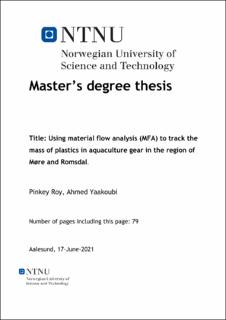| dc.contributor.advisor | Glavee-Geo, Richard | |
| dc.contributor.advisor | Tippett, Arron Wilde | |
| dc.contributor.author | Roy, Pinkey | |
| dc.contributor.author | Yaakoubi, Ahmed | |
| dc.date.accessioned | 2021-09-30T16:24:06Z | |
| dc.date.available | 2021-09-30T16:24:06Z | |
| dc.date.issued | 2021 | |
| dc.identifier | no.ntnu:inspera:86233229:86235362 | |
| dc.identifier.uri | https://hdl.handle.net/11250/2786746 | |
| dc.description.abstract | Dette prosjektet er en del av the blue circular economy (BCE) og er basert på tidligere arbeid utført av Deshpande et al. (2020) i å bruke materialstrømningsanalyse for å kvantifisere masser av plast, og fokusere i denne artikkelen på utstyr som brukes i fiskeoppdrett, spesielt i regionen Møre og Romsdal. Hovedformålet med denne studien er å utføre en materialstrømningsanalyse for å ha klar oversikt over bestander og strømmer av plast knyttet til havbruksnæringen i Norge, spesielt i det valgte området. I denne studien forsøkte forskerne å undersøke massen av plast (MoP) i akvakulturutstyret (AG) som ble brukt i akvakulturaktiviteter. I tillegg fremhever denne studien arten av forhold som eksisterer mellom avfallshåndteringsselskaper, akvakulturbedrifter og deres leverandører og produsenter av utstyr. Både kvalitative i form av online semistrukturerte intervjuer og kvantitative metoder i form av Material Flow Analysis (MFA) har blitt brukt til å analysere hele scenariet. Intervjuene avdekket de nåværende utfordringene regionen og landet står overfor med håndtering av plastavfall, spesielt generert fra havbruksnæringen, pluss de forskjellige strategiene som er angitt av de forskjellige aktørene og myndighetene i bransjen for å takle disse utfordringene. Mens resultatene fra UD viser at 52% av avfallsutstyret fra oppdrettsselskaper sendes til resirkulering, 14% deponeres og 34% forbrennes i regionen. Kombinasjonen av disse resultatene kan være nyttig for å få en bedre forståelse av akvakulturindustriens bidrag til å forurense havene, og informere derfor alle de viktigste aktørene som kan og bør iverksette tiltak for å motvirke dette problemet først og fremst gjennom bærekraftig forvaltning av plastutstyr. brukt i de forskjellige operasjonene. | |
| dc.description.abstract | This project is part of the blue circular economy (BCE) and is based on previous work done by Deshpande et al. (2020) in using material flow analysis to quantify masses of plastic, focusing in this paper on gear used in fish farming, especially in the region of Møre and Romsdal. The main purpose of this study is to perform a material flow analysis to have clear visibility of the stocks and flows of plastics linked to the aquaculture industry in Norway, especially in the selected area. In this study, the researchers tried to investigate the mass of plastic (MoP) in the aquaculture gear (AGs) used in aquaculture activities. Additionally, this study brings to light the nature of relationships existing among waste management companies, aquaculture companies, and their suppliers and manufacturers of gear. Both qualitative in the form of online semi-structured interviews and quantitative methods in the form of Material Flow Analysis (MFA) have been used to analyze the full scenario. The interviews uncovered the current challenges the region and country are facing with managing plastic waste, specifically generated from the aquaculture industry, plus the different strategies set forth by the different industry players and governments to deal with these challenges. Whereas the results from the MFA show that 52% of the waste gear from fish farming companies is sent to be recycled, 14% is landfilled, and 34% is incinerated in the region. The combination of these results can be useful to help have a better understanding of the contribution of the aquaculture industry in polluting the oceans and therefore inform all the key players who can and should take action to counter this problem primarily through sustainable management of the plastic gear used in the diverse operations. | |
| dc.language | eng | |
| dc.publisher | NTNU | |
| dc.title | Using material flow analysis (MFA) to track the mass of plastics in aquaculture gear in the region of Møre and Romsdal. | |
| dc.type | Master thesis | |
